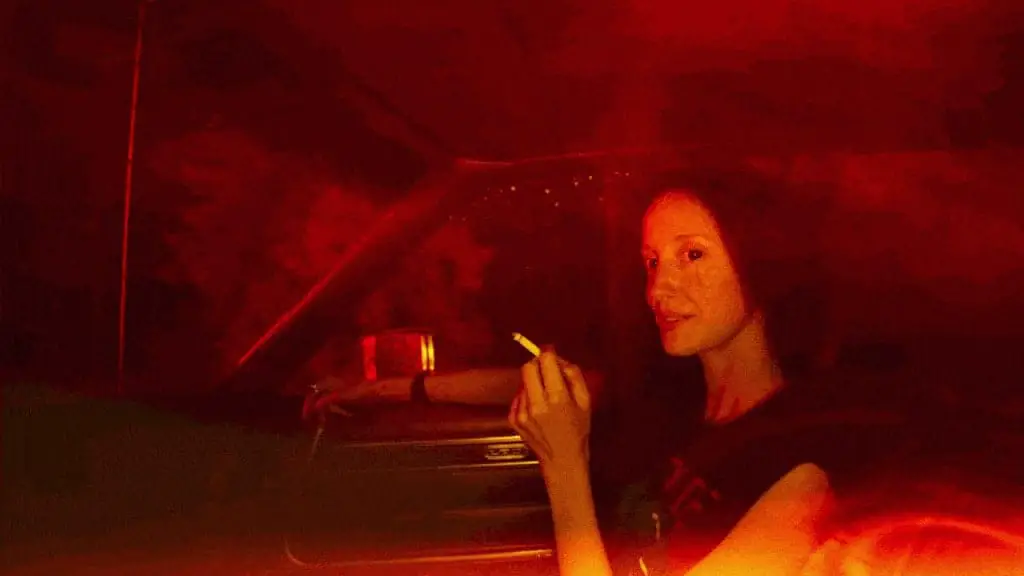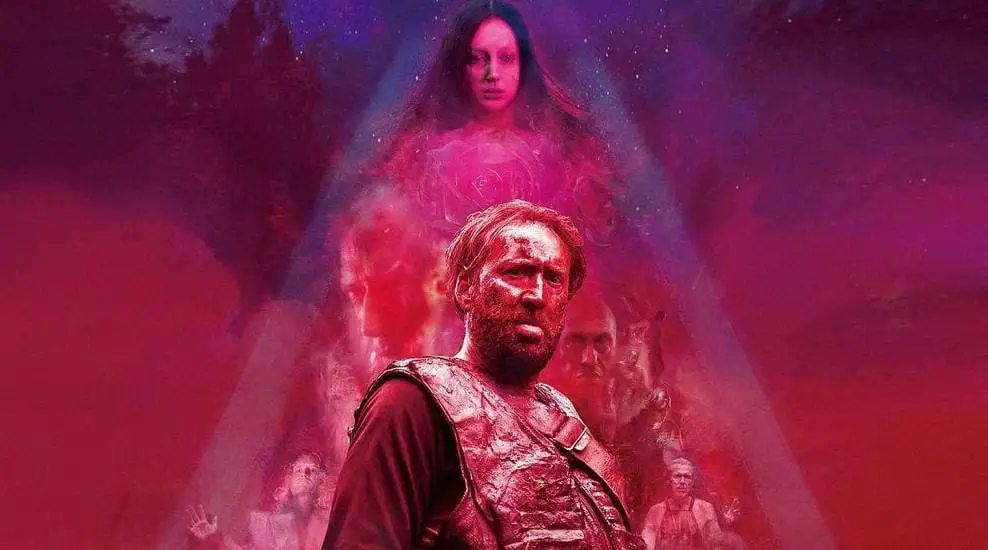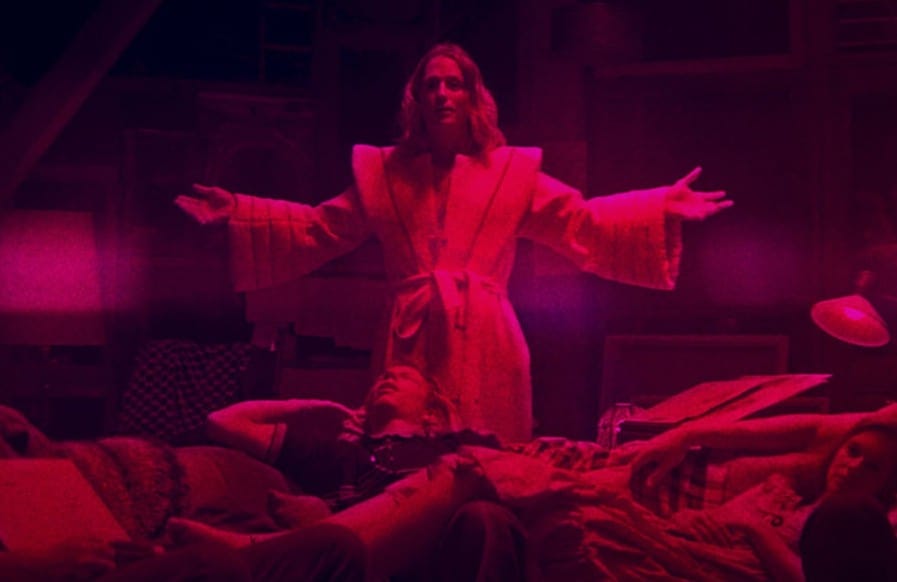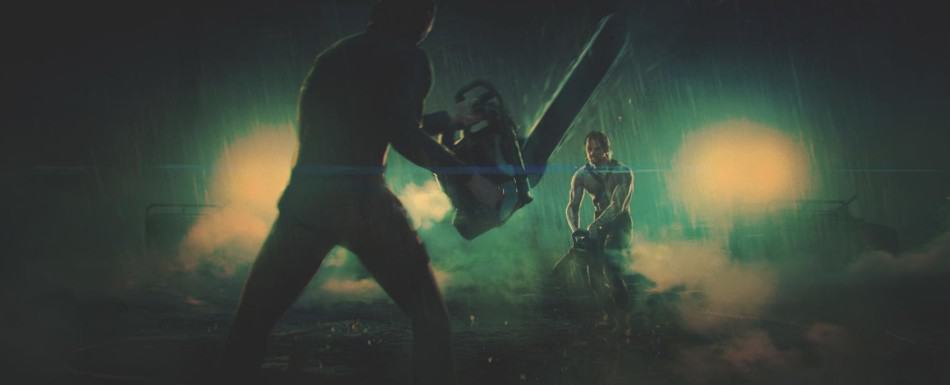What will happen if the freaky freedom of the late 60s of the last century is multiplied by the narcotic explosion of the 80s, the viewer is transported to the insane world of psychedelic fantasies and generously spiced with a heart-breaking soundtrack? This question was answered by the director Panos Kosmatos, the son of “that very” Kosmatos, who shot “Rimbaud-2”, “Cobra” and “Murder in Rome”.

The debut work of Kosmatos Jr., Beyond the Black Rainbow, was also done in the style of the 80s and was favorably received by critics. Panos decided to consolidate the success, and here is the result – at the time of its release on the screens “Mandy” received an unprecedented 100% on the Rotten Tomatos website, and some critics confidently called the picture a cult.
Tin Woodman Cage
Nicolas Cage’s Red Miller is a very recognizable character. Calm, self-confident, laconic “man with a past.” He lives with his young wife in a lonely house in the wilderness, works as a lumberjack. Judging by the fact that he keeps the weapon with his old friend, and not at home, he is a veteran who has gone through fire and water, who no longer wants to kill and drag along the ghosts of the war that has died down.

But soldiers are never former. An attempt to isolate oneself from evil does not lead to anything: as long as this evil is alive, as long as it exists in the world, it will certainly come to your doorstep and you will have to meet it face to face.
Phantom Mandy
The heroine who gave the film her name resembles a forest fairy. She is gentle, immersed in herself and her fantasies. Her drawings are a reflection of the unusual inner world of a young woman, inhabited by sorcerers and dragons. Mandy’s mystical mood, her gaze as a potential victim prepare the viewer for the most terrible plot development.

But mystical views are one thing, and life is quite another. Once in the sect of the newly-minted prophet Jeremiah “Children of the New Dawn”, even under the influence of strong drugs, she was able to separate truth from lies, fantasy from reality. You can read books about magicians and walk in black T-shirts with a Solomon star, but at the decisive moment, throw off this husk and understand who you really are and what your truth is. Mandy’s truth is her love for her husband and that world – real, not fantasy – that they built together in a small house by the lake.
Mandy doesn’t let herself be fooled, she doesn’t let her bend. She dies a terrible death, which leads the inconsolable widower on the warpath.
Jeremiah, Children of the New Dawn and the Hell Bikers
The failed musician and false prophet Jeremiah might seem like a fantastic creature if it weren’t for Charles Manson and his fanatical followers in recent American history. Manson’s “Family” wandering around the country brought chaos, pain and blood with it, but even decades later, the followers of the terrible “guru” did not abandon their “master”. He came where he wanted and took what he wanted. Jeremiah from “Mandy” is his younger brother from the 80s, equipped with powerful synthetic drugs and assistants – a gang of bikers.

“Children of the new dawn” are ready to go to death for the sake of their leader, they have no pity, no “I” of their own. They are completely subject to Jeremiah. Their eyes are empty, and joy only causes pain and the sight of death.
The gang of bikers, whose services Jeremiah resorts to when it is necessary to neutralize a dangerous enemy, terrifies with cruelty and BDSM-style costumes. Their images evoke in the memory of stenovers from “Hellraiser” and the biblical horsemen of the Apocalypse. But these are real and quite mortal people – drug couriers, on whom the LSD manufacturer tested non-standard “spoiled” products. To transform into a demon, it is not enough to put on a suit with spikes and get on a motorcycle. You have to lose your human essence, become a demon from within. Drugs do the job without the help of any occult force.
Sectarians, subordinate to an egoist and self-lover, intoxicated with a thirst for power, and crazy drug addicts – these are the killers of Mandy, who loved to read science fiction books and dreamed of wonderful unearthly worlds. They have not left the pages of these books; they are a product of real life.
The ordinariness of evil
Wounded, heartbroken, Red returns to the empty house. His life is destroyed, but the world around him lives its own life. Not a single thing in the house is touched, everything is intact. The lamps are still shining comfortably, Mandy’s things are lying, there is a sofa where the husband and wife loved to sit together and watch “horror films” on TV, and on the blue screen, a funny monster advertises oatmeal for breakfast.
It is simply impossible to imagine that Mandy is no more, that the wind blows the ashes of her burnt remains through the forest at that moment. This eerie contrast between outer comfort and terrible inner ruin is one of the most significant meanings of the film.

Revenge as it is
Red follows the trail of the killers and turns into a killer himself. The soul left him with Mandy. Alcohol, drugs, a high degree of rabies – we are no longer a man. “I am your God!” – says Red to the defeated enemy.
He does not think for a minute about turning to the representatives of the law. Neither the law nor the state seems to exist. Red and Jeremiah live in their own world, where the Old Testament principles operate. With each passing minute, the former woodcutter is sinking deeper into his visions, descended from Mandy’s paintings. At the end of the film, he completely leaves the real world, “driving” by car into a red fantasy forest under alien skies.
Color and sound
Blue, purple and crimson flashes of light from the first frames contrast sharply with the pacifying green of the forest. They symbolize the evil of human souls that distort reality. These flashes of color are not one-dimensional; they sway, swirl, resembling clouds or tentacles of giant jellyfish.
For the sake of complete immersion in the 80s, the director chose not stylization, but shooting on film, giving the “picture” grain, and the viewer – a feeling of travel in time.
Johan Johansson’s music sounds alarming, thrusting the hero deeper and deeper into the abyss of madness, tearing him away from the cozy idyll of a lumberjack-hard worker who has become a mad killer. The film opens with the track “Starless” by King Crimson. “Leave my rock and roll with me,” the epigraph calls out. Here it is – the quintessence of the 80s: rock, LSD, despair and empty words of politicians “about the spiritual rebirth of the nation.”

Death symbols
The film is full of symbolism. Red from a man turns into a wild animal – a tiger. He becomes his favorite hero – Galactus, the “devourer” of the planets. This is hinted at by his favorite T-shirt, animation fragments, the tiger freed from the cage by the Chemist.
Mandy’s story about the killing of starlings, a dead fawn found by her, a dialogue about her beloved planet are symbolic. Victim and murderer, wife and husband, peacefully living under one roof, lovers dozing under the crimson flashes of psychedelic skies. And there is only death ahead.
In the end, is it so important that you have a crossbow, a steel ax, a chainsaw or a stationery knife in your hands? It is important how you will live on when unnecessary weapons fall to the ground. For Red, the answer is obvious: nothing.







